If there really is a “climate crisis” – as opposed to climate hysteria – you’d think people would be encouraged to buy hybrids like the Toyota Prius.
Unlike electric vehicles, the Prius is a car almost anyone can afford – and more people driving a Prius rather than a relative handful of affluent people driving $50,000-plus EVs would be better in terms of reducing overall “emissions” of the dread gas carbon dioxide.
The Prius is also not an energy hog; it doesn’t tout the gratuitous consumption of energy (and of natural resources such as lithium) to deliver “ludicrous speed.” Instead it delivers almost 60 miles-per-gallon on average – and a range approaching 700 miles in between fill-ups that take less than five minutes.
So why isn’t the Prius being praised nearly as much as EVs are being pushed?
Probably because the Prius makes EVs and those who push them look stupid.
The Prius is the eponymous hybrid – the first one and the one that started it all, more than 25 years ago. There have been many emulators.
There is only one original.
In addition to being a hybrid, it’s also a hatchback sedan – which gives it the cargo-carrying capacity of a small crossover, without being yet another crossover. But like most crossovers, the Prius is available with all-wheel-drive, which has long been a crossover “sell.”
It also averages 57 miles-per gallon. In italics to emphasis that this figure isn’t highway miles per gallon. It is city and highway miles-per-gallon. Most non-hybrid cars don’t approach their highway mileage in city driving. And prior hybrids tended to use noticeably more gas on the highway than in the city.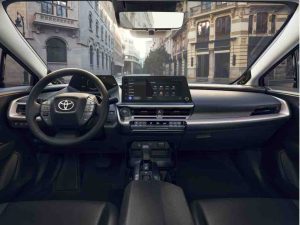
There’s also no EV that even approaches the 644 miles of city driving range the Prius offers – and none can recover all of that range in just a few minutes, either.
Prices start at $27,450 for the base LE trim, which is front-wheel-drive. Equipped with the optional AWD system, the MSRP is $28,850.
A top-of-the-line Limited with AWD lists for $35,865.
What’s New For 2023
The Prius has been given a major makeover. It is much sleeker-looking now and it lives up to those looks. The New Prius is the most powerful and quickest Prius yet – and the most fuel-efficient.
If you thought you couldn’t have your cake and eat it, too – well, you can.
There is one catch, however.
The improved performance (and economy) cost more this year. The all-new ’23’s base price is $2,375 higher than the $25,075 base price of last year’s Prius.
What’s Good
An electric car – without any of the disadvantages.
The practicality of a small crossover – that isn’t another crossover.
A hybrid car – without the usual disadvantages.
What’s Not So Good
Price uptick means it’ll take a little longer to recoup what you spent on the car via what you don’t spend on gas.
If it weighed less, it’d go even farther.
Sleek, low roofline cuts down on cargo space vs. the outgoing Prius.
Here’s an irony: Practically every new car – and truck – on the market comes with a smaller engine than it used to come with.
But the new Prius comes standard with a larger (2.0 liter) engine than the smaller (1.8 liter) engine that powered the prior Prius.
Isn’t that contrary to efficiency, the thing a Prius is supposed to be all about?
Somehow, it isn’t.
The ’23’s 2.0 liter engine is not only larger, it is much stronger – offering up 194 horsepower (total, with the additional scoot produced by the hybrid-electric side of the drivetrain) vs. the 1.8 liter’s 121. That’s a 73 horsepower uptick. The kind of uptick you’d expect to read about a new performance car offering. And the much-more-powerful Prius is a performer. It can get to 60 in about 7 seconds – vs. more than 10 seconds previously. That’s a better-than-three-second improvement.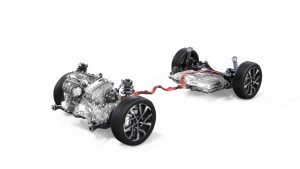
But what does this cost in terms of the car’s efficiency? Surely, it uses more gas than it did?
Somehow, it doesn’t.
In fact, it uses less.
The ’23 Prius gets 57 miles-per-gallon in city driving and 56 on the highway – vs. 58 in the city and 53 on the highway for the old model. Overall, the new Prius delivers about 2 miles-per-gallon better mileage than the older – and much slower – Prius.
You can also go farther faster in the new vs. the old: 632 miles on the highway vs. 598 on the highway for last year’s Prius. The old model did go a little farther in the stop-and-go (655 miles in city driving vs. 644 for the ’23). But the point here is the new Prius is a much better all-arounder. It has the power to be a highway car without sacrificing anything meaningful as an efficient car.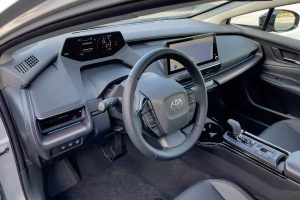
It is also a long-haul car, much more so than an electric car – because its battery is certain to last longer. In a hybrid like the Prius, the battery never runs out of charge because the system – the engine – is constantly replenishing its charge. There is also the fact that the engine is responsible for most of the propulsion; the battery (and electric motors) provide supplementary propulsion and (as regards the battery) provides power for the accessories when the engine isn’t running.
The practical result is that a hybrid’s battery leads a much easier life – and that is why hybrid batteries have long lives. It is why the Prius is very popular as a taxi – a type of vehicle that routinely racks up 200,000-plus miles in just a handful of years. And when the hybrid’s battery does eventually reach the end of its useful life, the cost to replace isn’t so high (relative to the value of the car) that it’s not worth replacing the battery.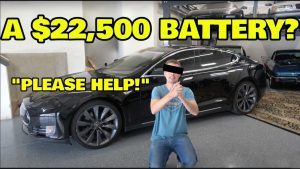
With EVs, when the battery goes, it’s time for the car to go.
So, there you go.
As before, a continuously variable (CVT) automatic transmission is standard and you can go with either the standard front-wheel-drive set-up or the optionally available AWD set-up. If you choose the latter, you’ll lose a few miles-per-gallon as a result of carrying around the extra 243 lbs. for the rear electric motor, which bumps up the curb weigh from 3,097 for the FWD LE to 3,340 lbs. for the AWD-equipped Limited.
On The Road
“Prius” has been the punchline of jokes about slow cars for the past 20 years. It was the price you paid to drive a car that could take you 20 miles farther down the road on a gallon of gas than almost any other car (the exception being VW’s TDI diesel-powered cars, which could travel nearly as far before they were forced off the market by the government for “cheating” on government emissions certification tests; this being like “cheating” the IRS out of your money).
The old Prius wasn’t even that slow.
In fact, it was about as quick (in terms of 0-60) as most family-type cars were until rather recently. Well, until the early 2000s, anyhow – when power/performance took an unprecedented Great Leap Forward such that modern family cars like the current Toyota Camry with its available V6 are quicker (and faster) than most V8 powered muscle cars were in the ’60s and ’70s.
And now the Prius is nearly as quick as many of the V8 muscle cars of the ’60s and ’70s. Most of these took 6-7 seconds to get to 60. The Prius does it in seven – while quadrupling how far you can go on a gallon of gas vs. the muscle cars of the ’60s and ’70s.
Of course, it doesn’t sound as quick as the muscle cars of the past – but it will run with them.
And that’s just amazing.
It also runs with much less apparent effort. The old Prius had just enough power to get going. It didn’t have much left to get going quickly when you were in a hurry. As when trying to merge with fast-moving traffic or pass slow-moving traffic. It could be done, but the car would let you know – per Scotty from Star Trek – that she was givin’ er all she’s got cap’n!
The engine would rev to near redline and the CVT would hold it there – until you backed-off the accelerator. But that was hard to do when you needed acceleration. The new car has about 40 percent more power – which means it has power in reserve. You don’t have to floor the accelerator to get acceleration.
This Prius is now a pleasant car; not just an extremely economical one.
At The Curb
This is the most radical Prius since the original – which looked radically unlike other cars because Toyota wanted it to look as radical (at the time) as it was. At that time, hybrids were not just new.
The 1997 Prius was the first of its kind – and looked it. There was no mistaking it for a normal car. This set it apart – as well as those who owned one. Everyone knew what it was they were driving. This became a kind of badge of honor but – in time – also became something else. There were a lot of people who liked the idea of owning a hybrid but didn’t want to make a big deal about owning one. The late ’90s and early 2000s were the era of the Hummer – and people who drove a Prius were sometimes made to feel like geeks for driving the anti-Hummer.
This Prius sheds the Mrs. Doubtfire image for one more in the line of her sexy daughter. If you didn’t know it was a hybrid you’d probably never guess. It looks like a new sport hatchback, something along the lines of a Civic – only sportier. The idea being to broaden this car’s appeal to encompass, well, everyone.
Because what’s not to like?
It looks good. It goes good. And it goes far.
There is a small price to be paid for this goodness, though. The sleeker/lower silhouette has reduced the available cargo space to 23.8 cubic feet from 33.4 previously. Even so, the hatchback layout greatly increases the usability of the space available because you can make use of most of the car’s interior to cart around items much too long to fit in the trunk of a sedan.
Like Toyotas generally, the “ergos” – i.e., the controls – are sensibly laid out. There is a touchscreen but you don’t have to tap/swipe to change channels or adjust the volume of the stereo. And there’s still a 12V power point readily accessible, so it’s easy to plug in accessories that use them, such as radar detectors.
Which you might want to use when driving this Prius.
The Rest
The Prius is a superb piece of engineering; any car that can almost hit 60 MPG on averge and still do 0-60 in about seven seconds is brilliant. But it could be even more so – if it were lighter than it is.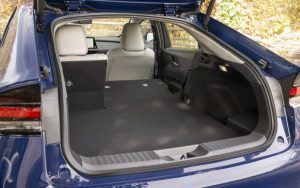
Relative to other new cars, the Prius isn’t heavy. But relative to the small cars of the past, it’s a porker. Even the LE – the lightest Prius – weighs almost twice as much as a ’70s VW Beetle. Much of the reason for all this weight can be laid at the feet of the government – which insists on “safety” as well as “efficiency.” The latter is easy enough to define. A car either is – or isn’t.
The Prius is.
But “safety” isn’t as easy to define. Was the ’70s Beetle “unsafe”? No, of course it wasn’t. If it had been the tens of millions of people who drove them would have been hurt driving them. Most weren’t. That doesn’t mean they wouldn’t get hurt if they wrecked their Beetle. But that is not the same thing as saying the Beetle was prone to wrecking; i.e., that it was unsafe.
Rather, it was less crashworthy. A different thing.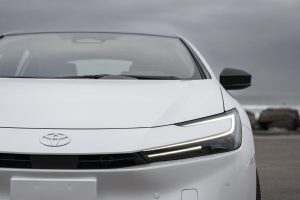
The Prius is very crashworthy – which is why it is very heavy. Lots of structural steel – and a bevy of air bags. But none of that matters if you don’t ever wreck – which you probably won’t.
Meanwhile, every time you drive, you use more gas than you would if this car weighed 500 or 1,000 pounds less. A 2,000 pound Prius would probably be capable of 75 miles-per-gallon.
Lots of people would probably prefer that over “crashworthiness.” But the government has decided that “crashworthiness” is more important than efficiency.
The Bottom Line
It might have been even better – but it’s pretty damned good, even so.
. . .
If you like what you’ve found here please consider supporting EPautos.
We depend on you to keep the wheels turning!
Our donate button is here.
If you prefer not to use PayPal, our mailing address is:
EPautos
721 Hummingbird Lane SE
Copper Hill, VA 24079
PS: Get an EPautos magnet or sticker or coaster in return for a $20 or more one-time donation or a $10 or more monthly recurring donation. (Please be sure to tell us you want a magnet or sticker or coaster – and also, provide an address, so we know where to mail the thing!)
My eBook about car buying (new and used) is also available for your favorite price – free! Click here. If that fails, email me at EPeters952@yahoo.com and I will send you a copy directly!



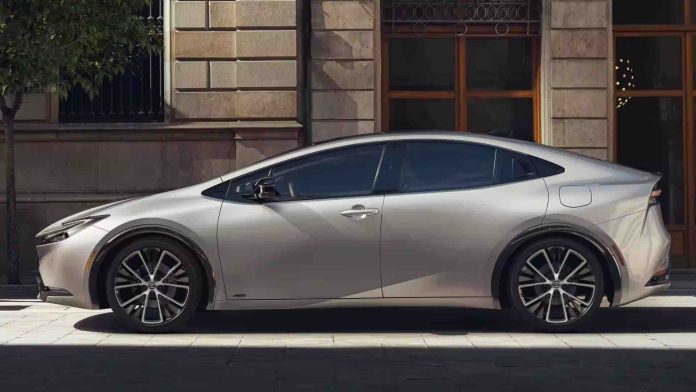


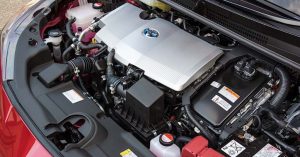








Had a 2007 Prius for a long time. Surprisingly tough machine. Good range but uncomfortable for longer trips because of the “driving” required. It was steery, easily pushed by wind, and you felt every crack in the pavement. But I loved it for errands here and there. I abused it, drove it hard, but it really earned my respect. Only thing is you have to get to feel of the CVT, the quick range, the slow range, hill climbing (no problems) etc. to really feel like you can hang with just about anything the HW can throw at you. Lots of storage!
Anyway, I never got stopped in the that old tan Prius. It seemed like you throw a bourbon bottle at a passing cop and they wouldn’t bother with you. Felt sorry for Prius drivers? I dunno. But I got a BMW and have been stopped twice, two warnings because you know how we do…
The hybrid corolla is very popular in Australia. Small car but not ridiculously small, very efficient, good all purpose vehicle if your family only buys one car.
NiMH batteries are a great choice in terms of reliability … because that’s why people choose Toyota in the first place. Every mechanic can service them, and spare parts are easy to get hold of. It won’t burn you to death.
I accept that someone has to pay for the roads … be that via taxation, or via toll roads you pay one way or the other. Problem in Australia is you pay a brutal fuel tax AND many major roads are toll roads AND an additional fee stacked onto your insurance AND there’s a hefty vehicle registration fee AND a license fee to be allowed drive at all PLUS local government taxes … and after all that the roads in my area have huge holes in them and lately the local government are sending letters around explaining we just have to pay a bit extra “Ta fix da road, ya know?”
But given the situation is what it is … might as well have something efficient if you can.
Oh by the way … electricity is also unaffordable in Australia, it’s more expensive than a lot of places in Africa. You can plug in your hybrid overnight and trickle charge, but you won’t see a big saving. Trick is to plug it in at the office and let the boss pay for that.
Sounds like a great car. Just wondering if late model hybrids use lithium batteries and are prone to fires like EVs are. If so, I wouldn’t want to park one in my garage.
Prius is a very good car to hypermile, this chart shows that if you slow down the Prius mpg goes way up:
https://priuschat.com/attachments/prius-mpg-vs-speed-jpg.48076/
All those mpg numbers Eric quoted in the article are at highway speeds of 65 mph. If you slow down to 40 mph your mpg goes up to 80 mpg. That is really incredible. Just think of the range. You might squeeze out 1,000 miles on a tank of gas.
So if gasoline got really expensive then a Prius could be a lifesaver, meaning you could still get around. Also, a car is very fast compared to walking, biking, horse riding. People think they need to drive like a bat out of hell. You don’t, it is just a concept in your mind, humans got around at much slower speeds than today and they had fine lives. The reason everyone speeds is because everyone is in debt and trying to make as much money as fast at they can to service said debt.
Our world is up to it’s eyeballs in debt, which is why our world is a frantic paced shithole. Debt is making us all mad. I will be glad when the whole thing implodes, maybe nuclear war will help us regains our sanity.
BTW, anyone can make a mpg vs mph with a new car that has instant mpg readout, just drive on the flat with no wind, at steady speed and record the mpg for 10 mph increments and draw a chart. Nerds who do this kind of stuff, drive both directions on the same road, take an average, to take out the wind factor.
When I first learned of the mpg vs. mph chart, for my Geo, I could not believe the numbers, so I filled it and drove really slow and measured my mpg. My Metro gets around 84 mpg if I drive 30-40 mph with gentle accelerations, etc. I’ve done this several times – and have duplicated the results, because I could not believe it the first time.
Yeah. I’ve heard that. Ideal, steady state crusing at 50 mph probably leads to the best gas mileage, however, in the real world, data tells a different story. In October 1973, we were hit with an Arab Oil Embargo that resulted in a 55 mph speed limit. Almost overnight, speeds over 75 mph disappeared from the freeways. Average speeds dropped from a recorded 65 mph in 1973 to 57 mph in 1974. Nixon got on the TV and told us about the benefits of slowing down to save gasoline.
The result?
According to the Energy Information Administration, fleet fuel economy, varied between 12 and 12.5 mpg from 1970 to 1976. The average fuel economy was in fact, lower in 1975 and 1976 than it was in 1970-72. Only in 73 was it lower. It amounts to statistical variation.
Slowing down to save gas did nothing to overall gas economy. Part of that has to do with the fact most gas is consumed in an urban environment, not over long stretches of rural interstate, though 25 percent of mileage was driven on roads that were posted over 55 mph back in those days.
So, these hypermiler prius drivers can brag about their gas mileage, but it will have no effect on anything going on in the real world.
I hated the 55 mph speed limit as a kid. I hate it even though it has long gone. The mentality that brought to us has not been completely eraticated. It is my expressed purpose to make sure that it never returns as long as I’m drawing a breath.
If there is a way out of this EV hellhole, maybe Toyota will lead it.
Always considered hybrids to be virtue signal cars, but they can have their place. Toyota was positioned with a cheaper car that got better mileage.
If they still have vision, they could bring us a bridge vehicle that will suffice until the government dictates crumble.
‘The Prius is a superb piece of engineering; any car that can almost hit 60 MPG on average and still do 0-60 in about seven seconds is brilliant.’ — eric
Damned straight: it’s a techno tour de force.
Yet Toyota, and now Ford, have to beg the EeeVee-obsessed EPA to make room in their draconian regs for a technology that’s here now, and saves energy beyond the wildest fantasies of a few decades ago.
Prius design always has been polarizing. I couldn’t stand the old slab-sided, squashed bug look. But the new update obliterates that objection. For the first time ever, the Prius is not a dowdy old maid. I wouldn’t be embarrassed to be seen in it.
A three-second improvement in 0-60 time, with no impact on MPG or range, ought to earn Toyota’s engineers a Presidential Medal. They hit the ball out of the freaking park, clear into the next county.
But will EPA ‘administrator’ Michael Regan, who couldn’t design a two-hole latrine if his life depended on it, recognize their magisterial achievement? Or will he sign its death warrant with his pending Elektrofahrzeuge für alle decree?
Each and every day, the US mf-ing fedgov undershoots my lowest expectations.
The political goal is no private automobiles for the masses, not reducing energy use or CO2.
If their goal was as they say then the fuel sipping diesel and hybrid technologies that are affordable and suffer no operational limitations would be embraced. But energy and CO2 is the excuse, not the goal. The goal is to reduce people’s mobility.
The people in government are not incompetent in the way they seem, they are deliberately pursuing an end goal using whatever excuses they can to get there.
The new better looking sheet metal will help it find buyers that otherwise wouldn’t have touched it with a ten foot pole. They will need those buyers. The glass roof actually looks really nice.
I have heard the true believers are mad that this new generation wasn’t made a “pure” electric only model.
Eric,
I have a question about the 2023 Prius: how does it HANDLE? In your review, you talked about its impressive fuel economy and performance, but nothing was said about handling. Is this car fun to DRIVE? How does it compare to the Mazda 3, the 3rd gen Ford Focus, or the MINI Cooper? I have experience with all three cars, and I consider them fun to drive when the road gets curvy. How does the Prius stack up against them?
Hi Mark,
It’s much more responsive to driver inputs than previously, but it’s not as athletic as a Mazda3 or Mini. Those cars emphasize sporty handling. The Prius is new to that game!
Thanks, Eric!
Still a dork mobile, and now with an explosive lithium battery.
Hard pass, I’ll find a diesel and gut emissions before I ever consider a hybrid. Still reeks of liberalism
I believe Eric when he says it’s a good car, but yeah, I don’t think I’ll be buying one soon. I’d get destroyed at the next garden party.
Good or not, it’s still a Prius, and as the Meme goes, Ron Burgundy reports that Prius is “Japanese for Homosexual”
Always been the gay, obnoxious villain in the automotive world, and while it’s overshadowed by EV’s, still a foe in my eyes
One of my daughters bought a Rav4 hybrid, one amazing automobile. Makes zero noise. It has the NiMH battery.
Push the ‘on’ button and it is ready to go, the word ‘ready’ is in green. The battery does the little work.
From Torque News, December 1, 2021:
“The fact that Toyota is still using NiMH is fascinating to me. The tech is proven, and it is safer than lithium-ion or polymer. Thermal runaway does not happen with NiMH, and safety is a big thing for Toyota.”
So why would Toyota switch to lithium batteries if Nickel metal hydride batteries are superior?
What gives?
Shareholders oust
“Automakers without a robust EV strategy are automakers in trouble. Toyota’s announcement today that it plans to start selling advanced battery technology in long-range EVs starting in 2027 is a clear attempt to assuage shareholder concerns at the meeting. Until Toyota stops fighting the electric vehicle future and commits to a 100% zero-emission vehicle line-up, shareholders should remain skeptical and continue to push for accountability.”
So says Electrek.
Some shareholders did plan to vote against Aiko Toyoda, so now you know where that comes from.
My concern is that these now have lithium batteries instead of the excellent NiMH batteries. Fire hazard?
After 18 years of looking at my next door neighbor’s 2005 Prius, with the license plate “OilsGone”. I always thought of the Prius as a dorkmobile. … But after looking at 2023 Prius photos here, and elsewhere, it’s now a good looking sub-compact car.
What is this world coming to?
The Prius is good looking
The Mustang EV looks like a generic SUV
Dementia Joe is President
Kamala “word salad queen” is VP
Trump os indicted for being a sore loser after the 2020 election, just like Hillary Clinton acted after she lost in 2016 (But I suppose being a sore loser was legal in 2016?)
My next door neighbor’s daughter turned non-binary, whatever that means, and had her breasts surgically removed. He could not believe it.
We are living in a bizarro world.
and dogs and cats are living together
Your neighbor’s daughter is mentally ill. Hey, it happens. From the sound of it, a real nutter too.
Has anyone noticed that the big Japanese companies haven’t gone all in on the whole EV thing?
Yes, Nissan has its Leaf (which is closer to what EVs should be than most EVs out there) and Subaru just rolled out its Solterra (which I think was motivated by the need to up its CAFE numbers; it’s not expected to sell big time), but Toyota and Honda have no straight up EVs, and Nissan and Subaru have only one. And Mazda has none at all.
It seems that once any automotive technology is truly refined, the Japanese companies jump on it and improve it. Some companies carve out a niche in technology; like Subaru with AWD and Toyota with hybrids.
I think that several factors are likely at play here:
First, the Japanese realize that more often than not, the leading edge is the bleeding edge and that first to market isn’t often first in the marketplace. They’re letting Tesla, Volvo, and Ford, as well as the Germans, take the hit on initial R&D with EVs. Should a viable mass-marketable technology or design emerge, the Japanese will see how it does, and then copy and improve it. That’s what they did with Lexus.
Next, the Japanese seem to get that there are a lot of obstacles to widespread EV adoption, some of which may be insurmountable. So they’re not going to make serious investments in EVs unless they feel that they’re truly ready for prime time—which they’re not.
Finally, and most importantly, I think that Japan realizes that when push comes to shove, energy security beats being green. I feel that we, as a country and as members of the human race at large, need to find ways to simply burn less fuel to not only reduce emissions of all kinds, but to reduce our vulnerability to energy dependence and insecurity. Hybrids are the most straightforward and practical way to burn less fuel—EVs are not. Widespread EV adoption will require us to burn MORE fuel at every point in the supply chain and use cycle.
So how is that?
EVs will require more fuel to mine the huge amount of minerals needed—and not just cobalt and lithium, but iron ore, copper, and aluminum for all the extra components of the power grid from generation to the plug, like cables, transformers, switchgear, and generators. And don’t forget the minerals needed for wind turbines and solar panels.
EVs will require more fuel to generate the electricity needed—and you know what? Not a peep is being uttered about expanding nuclear energy. That means mining and burning more dirty, nasty coal. That means more wind turbines that hurt birds, solar panels that have their own toxic chemicals, and damming up more rivers.
EVs require burning more fuel to make them—and dispose of them. ‘Cause EVs don’t last so long, do t forget, you’ll need to make more and dispose of them sooner.
Until then, hybrids make the most sense.
Excellent write up, Bryce. I agree with you 100%.
Honestly, I regret the USSA giving Japan such a hard time in the 1970s/1980s. Look where it got us…China. If Japan controlled the world we at least would have well manufactured products, a constitutional monarchy, and delicious healthy food instead we are settling for cheap disposable widgets, a one party authoritarian political system, and orange chicken made with MSG. The socialized credit score is just extra!
There are major differences between Japan and China. They’ve been enemies since the Han Dynasty with relatively brief peaceful times. But in the modern era they’ve been bitter enemies, and that divide is exploited by the CCP to encourage nationalism -many films approved for internal consumption have heroic leads who vanquish the Japanese devils- and of course there’s the constant sabre rattling drills by China and North Korea, directed at Japan.
Post war Japan accepted their defeat and embraced capitalism, but it was already fairly well established in the culture. The hubris and “they all look alike” racism of the Americans led to the asumption that the Vietnamese and Chinese were culturally the same as the Japanese and South Koreans. What they forgot was the horrors of the communist purges got rid of any independent thinking. As for giving Japan a hard time… look at the rust belt. Japanese manufacturers were clearly subsidized by the government for exports (same as China) but no action was taken in the courts that were largely established by the Americans. Not only that but at the same time US government was making it extremely difficult to do business and raising costs. A perfect storm for a shift in production centers to the east.
The last straw was acid rain legislation that set up so called cap and trade. Idea was to give busineses time to install sulphur sequestration devices. In practice it gave businesses time to shift production to China, where real pollution (not just CO2) is going to destroy the country before communism. Sure it got rid of acid rain, but also the jobs, the security and the tax revenue.
This “cap and trade” business is the greatest scam of all time, it must have been dreamed up by some Wall Street banksters. Without the “carbon credits” Eloon Musk “sold” to everyone else in the automotive industry he’d just be an ordinary grifter instead of a billionaire.
The idea of “carbon credits” is actually based on a concept floated a long time ago by none other than Murray Rothbard and other libertarians who saw it as a way for companies to deal with the costs associated with their pollution. Companies could “trade” pollution credits with companies that did not pollute to compensate for their pollution. Ironic that it is now used by government to punish companies. Libertarians saw this as a solution to compensate individuals NOT enrich corporate favorites.
Yeah, me too… sort of. Did you ever see the movie Gung Ho? It was about a japanese family that moved to the US to save a flailing US factory that was building Japanese brand name cars. It showed what a bunch of lazy butts we are and how we were going to get squashed.
An economy on life support since around 1982 or so made it so that Americans did eventuall rise up to the challenge of manufacturing Japanese spec automobiles. It is too bad that American culture was not altered at our corporate level, in our schools and at our homes.
We were too interested in playing during the 50’s and 60’s which led to partying in the 70’s through the early 80s. Then, things started getting weird.
The former Toyota CEO realized their hybrids were perfect for high fuel economy without the disadvantages of EVs.
The EV market is also tough to break into, with Tesla taking an early lead. Tesla’s 15% profit margin (NOT from selling stock) is the second highest in the auto industry. They have also been willing to cut their EV prices to make life tough for competitors.
Toyota “plans” to beat Tesla with a solid state EV battery, starting in 2026 models, if they can get the manufacturing costs under control.
Better batteries have been “coming” for a century. Solid state batteries are better, but the current manufacturing cost is much too high. An EV with a significantly better solid state battery would beat hybrids for fuel economy, possibly with a longer range, and the “refueling” time would at least be cut in half … but that’s still not competitive with hybrids or ICEs.
Electric motors are better than gasoline engines for automobiles, in my opinion, but the batteries have been a serious weak link for over a century. Maybe that will change in ten years?
Says you. Yes, electric motors can ostensibly accelerate faster, but they are terrible vehicles to be driven at speed and for long distances. Turn on your heater in the winter on and it will dim the lights like an electric toaster.
I’m not the least bit interested in sitting around for a minimum of 1/2 hour for a “charge” to 80 percent battery life. My Honda Pilot gets 18 mpg no matter how far or fast you drive it. My TL gets 24-30 mpg combined/freeway mileage. Both take 7 minutes to fill.
Unless some battery powered car can get me 800 miles on a charge at 80-85 mph cruising speed, which is the upper limit of what I can drive in a day, I’m frankly not the least bit interested. I drive around 40,000 miles a year.
Modern carmakers, the Biden Administration and anyone else trying to shove this electric bullshit down my throat can kiss my fucking gas.
In regards to the Japanese not going all in on EV’s. I spoke to a Honda engineer recently and this is what he told me. Honda is a MOTOR company. Not just a car company. They consider themselves the masters of the universe when it comes to making ICE engines. They make them for everything. Cars, motorcycles, mowers, watercraft, snow mobiles, generators. They are very proud of their quality. Typically 300,000+ miles out of a car engine. But all of their years of expertise, engineering and research are about to be tossed away so crappy engineering places like GM and Ford can hook a battery to an electric motor (which those companies don’t make) and push companies like Honda to the side. All for a ginned-up climate emergency. They are not happy about it.
Cashy, f off and go away. Just because you happen to write a comment that’s not designed to instigate a reaction, doesn’t mean you’re not a miserable, vile troll. You’re a loser and henceforth you shall be treated as such without exception.
Thank you Mr. Liberty for the trenchant commentary on my remarks, as you frequently provide. It’s also good to see you kidding me with your gentle ribbing concerning my posts and myself personally. Rest assured the feelings are mutual. The offer to accompany me on a round of golf still stands.
Go away troll.
The troll speaks for itself:
“Cashy August 2, 2023 At 12:50 pm
As the great Josey Wales said: Buzzards gotta eat, worms gotta eat, trolls gotta eat!”
Hi ML,
I can’t say I agree with a lot of Cashy’s posts, but I don’t feel his post on Honda motors it the least bit instigative. We do not have to hold hands and sing “Kumbaya”, but he does make a valid point on Honda’s target to try to avoid the EV party and focus on what they do best.
I am glad to hear Honda is converging on this. I have driven Japanese cars for half of my life. If they continue to make ICE or hybrid motors I have no problem driving them for the last half of my life.
RG: I don’t think you read my post correctly. This is Cashy’s MO. He occasionally writes a non-instigating post that causes everybody to forget that he’s a troll. This tactic works so well, Cashy now has you defending him/her/it. Then, as soon as everybody forgets what an asshole this creature is, the asshole comes back out and strikes. That’s what trolls do. Cashy, no doubt, is schooled in the art of trolling assholery.
Sorry, Cashy is only here for the purposes of being a troll and nothing more. Cashy brings nothing to the table and is not here in good faith (including his little made-up Honda post). He/she/it is a first-class asshole and he/she/it will treated as such.
I have no patience for people who post comments in bad faith like Cashy.
Hi ML,
Do not let him/her get to you. The raise in blood pressure isn’t worth it. We all deal with a variety of people on a day to day basis – some we love, some we detest, and others we merely put up with. If someone is willing to be nonbelligerent (at least for the time being) we needn’t go on a full fledged attack mode. All it does is prove to the other person that they got under your skin. Don’t give them that power. Ignore them, that aggravates trolls/bullies more than anything and when they make a beeline for you because they can’t take it anymore…punch them in the face.
Cashy doesn’t raise my blood pressure in the slightest bit. He just needs to be called out for what he’s doing.
Your icon has changed three different times in this thread. I know when that happens to me it is because I am typing my email too fast (or I type in the wrong one) because somebody or something has irked the hell out of me. 😉
Huh, I just noticed that. Perhaps it’s my poor typing skills.
Fuck off, troll.
Fuck off, troll.
One thing the Japanese understand is that China is next door. They gotta be ready. Lots of bad blood betwixt Japan an China.
RE: Weight. Hard to beat steel for strength. Carbon Fiber composite does that and more, pound for pound it is off the scale, beating everything from steel, aluminum and even titanium. The raw material is cheap. So why is it relegated to super-exotics and aircraft? Because there’s no way to mass produce it beyond simple shapes. Car bodies are made from tool and dies and giant presses. Carbon fiber is cut like fabric, laid out in forms, put into vacuum sealed bags and baked overnight. Then it needs to be inspected for voids and bubbles. It is a labor intensive process that doesn’t lend itself easily to assembly lines. My CF gravel bike frame is much stronger than my antique Reynolds 520 chrome-moly touring frame. The tourer was a custom build made in a small shop in upstate New York, while the gravel is a standard size frame made in either India or Taiwan (I’m not sure which). And the gravel bike was still more expensive in real dollars.
Much like you-know-what there’s always a hope for a big breakthrough in carbon fiber production that will put it on an even footing with steel. So the regulators demand innovation in an attempt to force it. If it were that easy it’d be done already.
Eric, interesting that the AWD Prius uses an electric motor to drive the rear wheels. That’s not the case with the Corolla hybrid AWD, is it?
The AWD Prius and AWD Corolla BOTH add an electric motor to the rear axle to spin the rear tires.
The Prius AWD-e uses a magnet-free electric motor that drives the rear wheels from 0 to 10 km/h, and when necessary, up to 70 km/h. This system provides power to the rear wheels when accelerating from a stop. If the conditions do not require all-wheel drive, the system automatically switches to FWD to lower fuel consumption.
The Prius AWD-e is fitted with the nickel metal-hydrid type while others use a Lithium-ion battery. Compact and designed to offer excellent cold-temperature performance, it’s nested in the same spot, under the back seat.
Thanks, Richard. I have one and I did not know that.
Completely vouch for Toyota’s hybrid system these days. Our ’21 Highlander Hybrid, with 73K on the clock, is getting 35 MPG. If I had my taxes back, I’d buy my daughters two of these little buggers.
Ditto, Scooter –
I like fast cars. I also like smart cars. This is one!